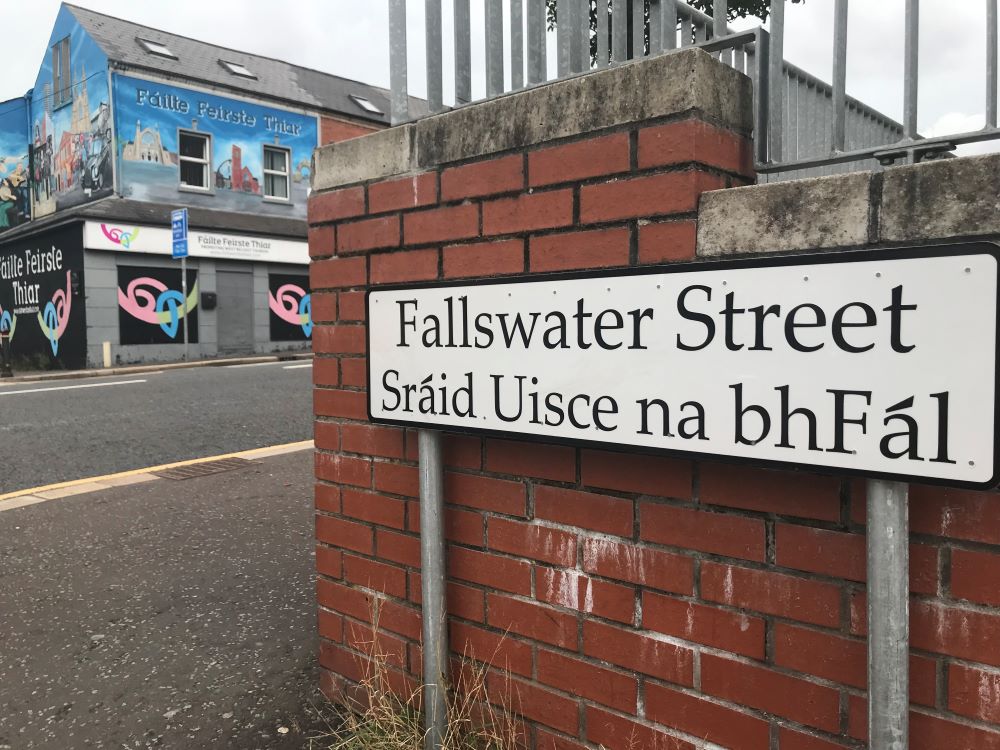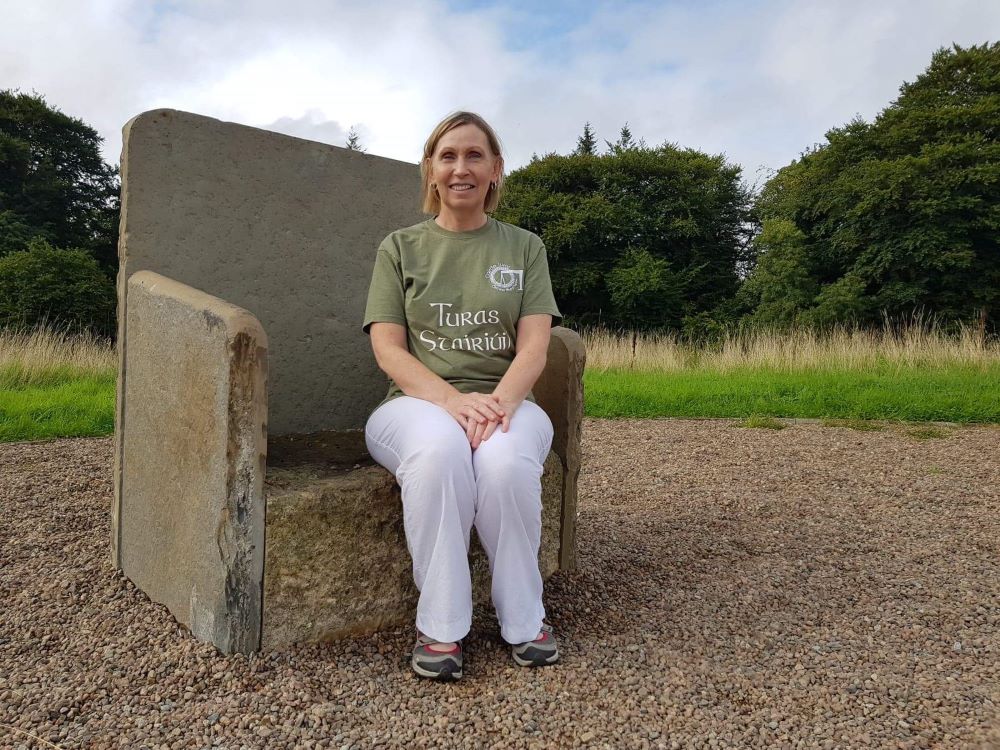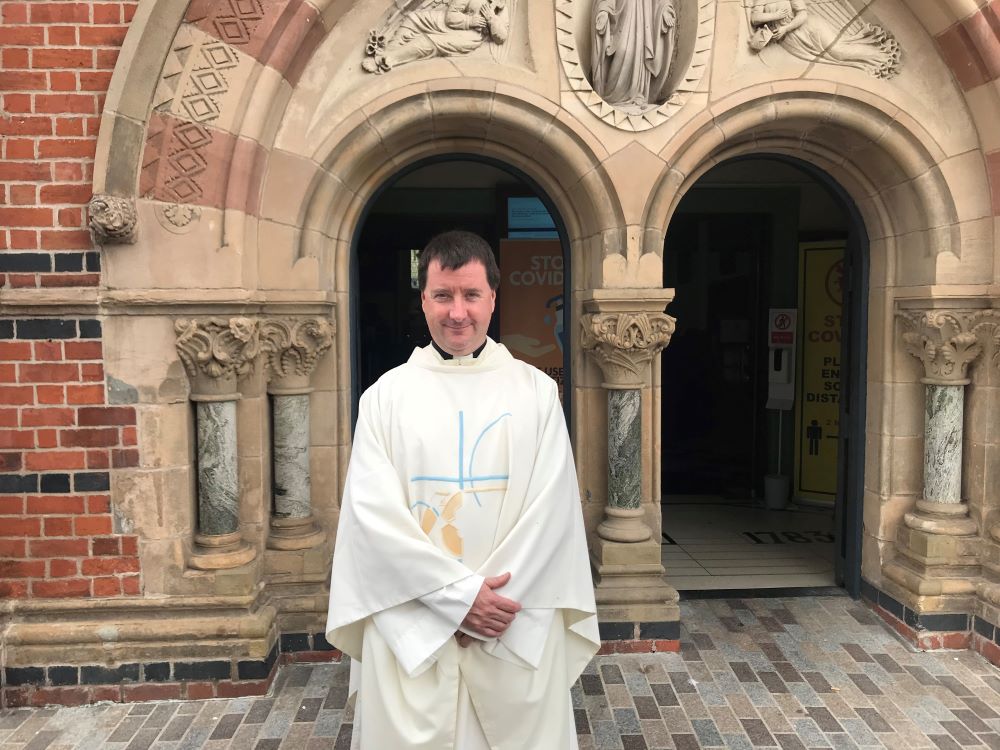
A street sign in West Belfast uses both the English and Irish languages. (NCR/Claude Colart)

Linda Ervine sits on a replica of the ancient stone chair used to inaugurate the Gaelic Chieftains of Clandeboye in Northern Ireland. Ervine, founder of Northern Ireland's first integrated Irish language preschool, has faced bullying and intimidation. (Provided photo)
The announcement of Northern Ireland's first integrated Irish language preschool was enthusiastically received and soon its 16 places were filled by among others, the children of mixed — Catholic and Protestant — marriages.
But a hate campaign against the naíscoil and its founder Linda Ervine quickly emerged on social media and on lampposts, driving her to consider moving it from the grounds of a primary school to protect the children.
A Protestant, Ervine is a dedicated Unionist — she identifies as British and hopes that her birthplace will always remain part of the United Kingdom, as it has been since its creation in 1921.
"It's been tough, it's been depressing, it's been very stressful for all of us," she said of the bullying and intimidation, which included her face being superimposed on posters of the nationalist Sinn Fein party accompanied by the words: "Every word of Irish spoken is like another bullet being fired in the struggle for Irish independence."
"The idea that somebody would deny me the right to speak Irish because I'm a Protestant and tell me that I'm doing something wrong, is some form of insanity," Ervine told NCR.
Advertisement
Over the years Northern Ireland's divisive politics have led the ancient Irish language, once spoken by all here, to be identified more with Catholic and nationalist communities, who broadly seek for the territory to be a part of the Republic of Ireland from which it was carved a hundred years ago.
After the United Kingdom's decision to leave the European Union, the Irish language has become even more of a political touchstone. Identity is a sensitive issue across Ireland and politicians often use questions of "Britishness" or "Irishness" to rally their supporters. That's likely to be ramped up as the May 2022 Northern Ireland Assembly election approaches.
Still to be legislated here is the Irish Language Act, Acht na Gaeilge. While a growing number of unionists are comfortable with Irish, many Unionist politicians oppose its proposed formal recognition as an official language alongside English, as the Welsh language is in Wales.
"The Irish Language Act will provide statutory protection for the language and will, essentially, remove it from the whimsical decision-making of whatever politician finds him or herself in a position to decide what should or should not happen with the language," said Niall Comer, a lecturer in Irish at Ulster University.
Comer said the act "will also recognize Irish as an official language of Northern Ireland and help to end years of persecution and under-development of a language that was once spoken throughout Ireland."

Fr. Darach MacGiolla Cathain, shown here at St Mary's Chapel Lane, was born and raised in Shaw's Road, a West Belfast Irish speaking community his parents helped to establish. Once a month he celebrates Mass in Irish at St. Mary's, Belfast's oldest Catholic church. (NCR/Claude Colart)
Speaking Irish is nothing new for Fr. Darach MacGiolla Cathain, who was born and raised in Shaw's Road, a West Belfast Irish speaking community his parents Adam and Monica helped to establish.
A pioneering group of 12 couples decided in 1969 to create the community, raised funds and built their own houses. As children were born, the parents drew together to start Northern Ireland's first Irish language preschool. They then campaigned for primary schools and later secondary schools. Today Belfast is served by some 15 Irish language middle schools and two high schools.
The Shaw's Road community lies at the heart of the West Belfast Gaeltacht, an Irish speaking community, said MacGiolla Cathain, who coordinates the chaplaincy for Irish middle school education in the Diocese of Down and Connor.
Of the five Catholic dioceses in Northern Ireland only two, Down and Connor and Dromore, lie entirely within the British nation's boundaries. The other three are partly in the Republic of Ireland, where Irish is the national language and a compulsory school subject. Gaeltachts can be found in several of the Republic of Ireland's 26 counties.
Once a month MacGiolla Cathain celebrates Mass in Irish at St. Mary's Chapel Lane, Belfast's oldest Catholic church, and greets parishioners in their native tongue. Dia duit ("God be with you") is traditionally how Irish speakers say hello. The response is Dia's Muihre Duit ("God and Mary be with you").
When responding to a priest, however, the response is Dia Duibh ("God be with you" in the plural).
St Mary's, where MacGiolla Cathain was baptized, was built in 1784, largely with funds raised by Presbyterians and The Church of Ireland, when only 365 Catholics, about 8% of the population, lived in Belfast.
The number of Catholics reached about half the city's population by 2011, and the latest figures from the 2021 Census will be published next year.
It is the only church in Down and Connor to celebrate Mass in Irish weekly. Others might do so on occasions like St. Patrick's Day or when people request Irish language services for First Communions, weddings and funerals.
"It's obviously more prevalent in the likes of Donegal," said MacGiolla Cathain, referring to a Republic of Ireland county, where he said celebrating Mass in Irish is "about as unremarkable as Mass being celebrated in Spanish in Spain."
The priest said he measures the "growing appreciation for the language" in Northern Ireland by the number of Irish language confirmations in his diocese. "Around seven years ago the number of children was around 200, now it's around the 300 mark — a 50% increase," he said.
"It's not about claiming, it's about reclaiming because the Irish language does not belong to one religious group or another, it belongs to everybody."
— Fr. Darach MacGiolla Cathain
Ervine's new school, named Naíscoil na Seolta, was set to open in September in the predominantly Protestant East Belfast. She chose the name na seolta or "the sails" as a nod to the area's shipbuilding history including, most famously, the RMS Titanic.
She fell in love with the language on a six-week taster course as part of a cross-community women's group and has been teaching it to beginner adults for nearly 10 years, an achievement that saw Queen Elizabeth II awarding her a special honor this year for her services to the language.
Her classes on behalf of the Methodist Church's East Belfast Mission started in November 2011 and the next September saw the establishment of a center named Turas, meaning journey or pilgrimage in both Irish and Scottish Gaelic.
Seeing attendance grow "year-on-year" in East Belfast convinced Ervine of an increased interest in Irish there. She decided to open a naíscoil after being invited by Braniel Primary School's principal Diane Dawson to teach Irish as part of a post-COVID-19 lockdown "recovery program" in March.
Dawson, also a Unionist, was thrilled at the results. She introduced Irish, Spanish and sign language to gently ease the children back into a school environment.
She delights in a mother's recollection of a scene in the back of her car when the children's iPad stopped working. She overheard her 8-year-old ask her 5-year-old: "What is two plus two? Tell me the answer in Irish."
"A ceathair," the 5-year-old responded: Four.
When Ervine wondered aloud if there was space for an Irish language preschool, Dawson immediately suggested an empty mobile classroom on the property.
Within weeks the education authorities granted permission and two years of funding was secured from Foras Na Gaeilge, which promotes the Irish language throughout Ireland.
While only three complaints came from parents of Braniel Primary School, most of the resistance to the naíscoil was falsely claimed to be from the community, Dawson said. In reality, some votes against the school were from different parts of Northern Ireland and some from as far as England and Scotland.
Both Ervine and Dawson took the threats seriously, mindful of the 2001 attacks on children walking through a Protestant area to the Holy Cross Girls Primary School. "We knew it cannot be another Holy Cross," said Ervine.
She is determined to open the naíscoil and is confident that someday it "will just be part of our history and it will show how far we've come."
If she could, Ervine would tell the naíscoil's opponents: "Come and sit down with me. Have a cup of tea and let's talk about the issues that you have, reasonably and rationally."
MacGiolla Cathain calls Ervine's work "tremendous."
Reflecting on her trailblazing efforts half a century after his parents' own contribution to the Irish language, he said: "It's very important just to break down those barriers. It's not about claiming, it's about reclaiming because the Irish language does not belong to one religious group or another, it belongs to everybody."
[Sahm Venter is a freelance journalist and the editor of several books, including The Prison Letters of Nelson Mandela.]







